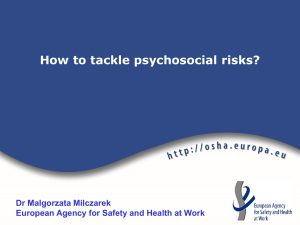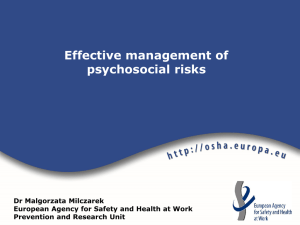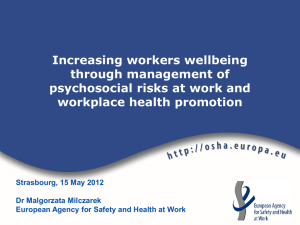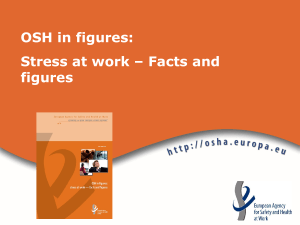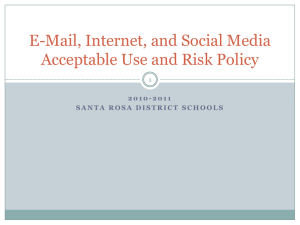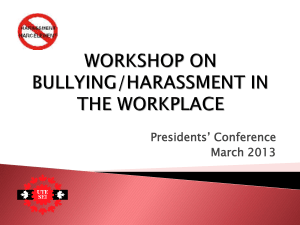Work-related stress Dr Malgorzata Milczarek European Agency for
advertisement
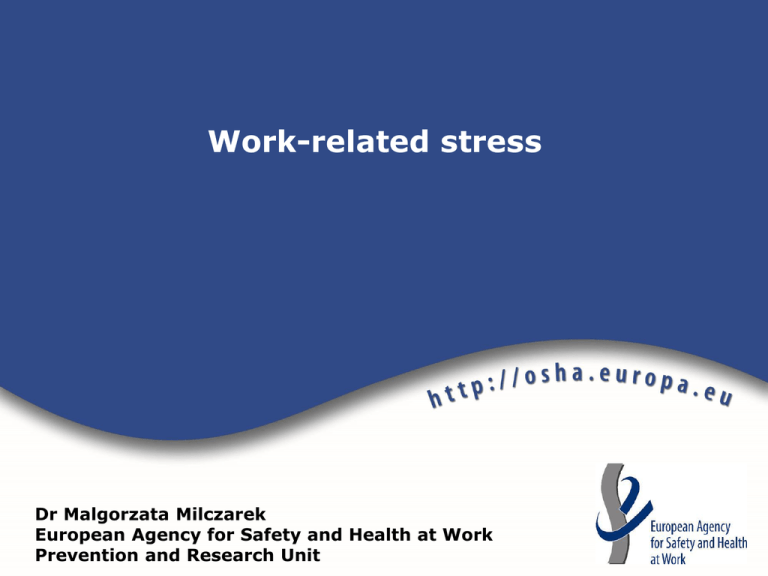
Work-related stress Dr Malgorzata Milczarek European Agency for Safety and Health at Work Prevention and Research Unit EU-OSHA The European Agency for Safety and Health at Work was established in 1996 in Bilbao to help improve working conditions in the European Union EU-OSHA: identifies emerging risks (research) consolidates knowledge (reports) stimulates debate (seminars) collects and disseminates good practice information organises raising-awareness campaigns develops and disseminates practical tools FOCAL POINTS EU Focal Points Candidate & Potential Candidate Countries EEA/EFTA Focal Points Work-related stress: facts Work-related stress is one of the biggest health and safety challenges that we face in Europe. Stress is the second most reported work-related health problem. EU Labour Force Survey (2007): 28% of workers reported that work negatively affects their mental well-being 14% of workers who reported work-related health problems, expirienced stress, depresion, or anxiety as the main problem The number of people suffering from stress-related conditions caused or made worse by work is likely to increase Work-related stress Stress: definition and causes People experience stress when they perceive that there is an imbalance between the demands made of them and the resources they have available to cope with those demands. Although the experience of stress is psychological, stress also affects people’s physical health. Symptoms of work-related stress Organisational: o absenteeism, high staff turnover, poor time-keeping, disciplinary problems, harassment, reduced productivity, accidents, errors, and increased costs from compensation or health care. Symptoms of work-related stress Individual: o o o o Emotional: irritability, anxiety, sleep problems, depression, hypochondria, alienation, burnout, relationship problems Cognitive: difficulty in concentrating, remembering, learning new things, making decisions Behavioural: abuse of drugs, alcohol, and tobacco Physiological: back problems, weakened immunity, peptic ulcers, heart problems, hypertension. Research on emerging psychosocial risks The expert forecast on emerging psychosocial risks was carried out in 2003 and 2004 by means of the Delphi method. Mean values on the 1-to-5 point Likert scale and standard deviations The 10 most important emerging psychosocial risks identified in the survey 6.00 5.00 4.56 4.38 4.25 4.25 4.19 4.00 4.13 4.07 4.06 4.00 Lean production and outsourcing High emotional demands at work 4.00 3.00 2.00 1.00 0.00 Precarious contracts in the context of unstable labour market Increased workers' vulnerability in the context of globalisation New forms of employment contracts Feeling of job insecurity Ageing workforce Long working hours Work intensification Poor work-life balance Research on emerging psychosocial risks The main emerging psychosocial risks identified in the forecast: New forms of employment contracts and job insecurity (the use of more precarious contracts together with the trend towards lean production and outsourcing) The OSH risks for the ageing workforce Work intensification (high workload and work pressure) High emotional demands at work (including violence and bullying) Poor work-life balance All of these risks affect workers’ health and safety. They may lead to serious deterioration of mental and physical health. ESENER-PR European Survey of Enterprises on New & Emerging Risks – Psychosocial Risks 2009 EU-OSHA research ESENER survey Europe-wide establishment ESENER Survey asks managers and workers' representatives about how health and safety risks are managed at their workplace, with a particular focus on the workrelated stress, violence and harassment. Computer-assisted telephone interviews (“CATI”) 2 questionnaires 31 countries: 36,000 interviews (2009) 41 national versions of each questionnaire “Enterprises” = both public and private sectors http://esener.eu How are the ‘new’ psychosocial risks such as stress, violence and harassment being managed? Main concerns and causes Level of concern about stress, violence and bullying or harassment; what are the principal risk factors (e.g. time pressure, poor communication, job insecurity, etc.)? Measures taken Ad-hoc or ‘reactive’ measures (e.g. training, change to work organisation, work area redesign, confidential support, changes to working time, conflict resolution) Procedures in place More formal or system based than ‘measures’, e.g. procedures to deal with stress, with violence or with bullying or harassment Main concerns about workplace risks Level of concern about various health and safety issues % establishments, EU27 10 0 90 80 70 60 50 40 30 20 10 Major concern Some concern No concern Bullying or harassment Violence or threat of violence Noise and vibration Dangerous substances WR Stress MSDs Accidents 0 DK/ NA Main concerns and causes Concern regarding work-related stress % establishments 100% 90% 80% 70% 60% 50% 40% 30% 20% 10% Major concern Some concern No concern DK/ NA IT FI LT SE NL EE HU CZ M T UK SK IE BE DK HR LV CH -2 7 ES EU E TA L L 31 TO SI LU CY FR AT DE BG RO PL TR NO PT 0% Main concerns and causes Concern about various psychosocial risk factors % establishments, EU27 100 90 80 70 60 50 40 30 20 10 0 Time pressure Having to deal Poor w ith difficul communication customers, betw een patients, pupils, management etc and employees Job insecurity Poor cooperation amongst colleagues Long or irregular w orking hours Problems in supervisor employee relationships Lack of employee control in organising their w ork An unclear human resources policy Discimination for example due to gender, age or ethnicity Procedures in place Concern about work-related stress, bullying or harassment, or work-related violence % establishments, EU27 Health and social w ork Education Public administration and defence; compulsory social security Real estate, renting and business activities Financial intermediation Other community, social and personal service activities Mining and quarrying Transport, storage and communication EU-27 Wholesale and retail trade; repair of motor vehicles, motorcycles and personal and household goods Hotels and restaurants Construction Electricity, gas and w ater supply Manufacturing 0 Bullying or harassment 10 20 30 Violence or threat of violence 40 50 60 70 80 Work-related stress 90 100 Main concerns and procedures in place Concern about work-related stress and existence of procedures to deal with it % establishments 100 90 80 70 60 50 40 30 20 10 Major/some concern Procedures IT SK M T H U LT H R EE N L CZ T A IE EL BE D K K U LV SI CY FI TO C TA H L 31 EU -2 7 LU SE ES BG O R PL PT FR D E TR N O 0
